GIGA BYTE TECHNOLOGY GN-WI01GS-RH Mini-PCI Wireless Adapter User Manual GN WI01GS1 EMI Manual 090721
GIGA-BYTE TECHNOLOGY CO., LTD. Mini-PCI Wireless Adapter GN WI01GS1 EMI Manual 090721
User manual

GN-WI01GS-RH
Mini-PCI Wireless Adapter
User’s Manual
http://www.gigabyte.com.tw
Rev. 1.0 First Edition
Federal Communication Commission Interference Statement
This equipment has been tested and found to comply with the limits for a Class B digital device,
pursuant to Part 15 of the FCC Rules. These limits are designed to provide reasonable protection
against harmful interference in a residential installation. This equipment generates, uses and can
radiate radio frequency energy and, if not installed and used in accordance with the instructions,
may cause harmful interference to radio communications. However, there is no guarantee that
interference will not occur in a particular installation. If this equipment does cause harmful
interference to radio or television reception, which can be determined by turning the equipment off
and on, the user is encouraged to try to correct the interference by one of the following measures:
-Reorient or relocate the receiving antenna.
-Increase the separation between the equipment and receiver.
-Connect the equipment into an outlet on a circuit different from that to which the receiver is
connected.
-Consult the dealer or an experienced radio/TV technician for help.
This device complies with Part 15 of the FCC Rules. Operation is subject to the following two
conditions: (1) This device may not cause harmful interference, and (2) this device must accept any
interference received, including interference that may cause undesired operation.
FCC Caution: Any changes or modifications not expressly approved by the party responsible for
compliance could void the user's authority to operate this equipment.
IMPORTANT NOTE:
FCC Radiation Exposure Statement:
This equipment complies with FCC radiation exposure limits set forth for an uncontrolled
environment. This equipment should be installed and operated with minimum distance 20cm
between the radiator & your body.
This transmitter must not be co-located or operating in conjunction with any other antenna
or transmitter.

This device is intended only for OEM integrators under the following conditions:
1) The antenna must be installed such that 20 cm is maintained between the antenna and
users, and
2) The transmitter module may not be co-located with any other transmitter or antenna.
As long as 2 conditions above are met, further transmitter test will not be required. However,
the OEM integrator is still responsible for testing their end-product for any additional
compliance requirements required with this module installed (for example, digital device
emissions, PC peripheral requirements, etc.).
IMPORTANT NOTE: In the event that these conditions can not be met (for example certain
laptop configurations or co-location with another transmitter), then the FCC authorization is
no longer considered valid and the FCC ID can not be used on the final product. In these
circumstances, the OEM integrator will be responsible for re-evaluating the end product
(including the transmitter) and obtaining a separate FCC authorization.
End Product Labeling
This transmitter module is authorized only for use in device where the antenna may be
installed such that 20 cm may be maintained between the antenna and users (for
example :AP/Router/Motherboard). The final end product must be labeled in a visible area
with the following: JCK-GN-WI01GS-RH
Manual Information That Must be Included
The OEM integrator has to be aware not to provide information to the end user
regarding how to install or remove this RF module in the users manual of the end
product which integrate this module.
The users manual for OEM integrators must include the following information in a prominent location
“ IMPORTANT NOTE: To comply with FCC RF exposure compliance requirements, the antenna used for this
transmitter must be installed to provide a separation distance of at least 20 cm from all persons and must not be
co-located or operating in conjunction with any other antenna or transmitter.
Contents
END PRODUCT LABELING 3
MANUAL INFORMATION THAT MUST BE INCLUDED 3
CHAPTER 1. PRODUCT OVERVIEW 1
1-1. INTRODUCTION...........................................................................................................1
1-2. FEATURES .................................................................................................................1
1-3. PHYSICAL DIMENSIONS/PACKAGING.............................................................................1
1-4. SYSTEM REQUIREMENTS ............................................................................................2
CHAPTER 2 HARDWARE SPECIFICATIONS 3
CHAPTER 3 USING THE GIGABYTE WLAN CONFIGURATION UTILITY 4
3-1. THE PROFILE TAB ......................................................................................................4
3-2. THE LINK STATUS TAB ..............................................................................................11
3-3. THE SITE SURVEY TAB .............................................................................................12
3-4. “STATISTICS” SETTING ..............................................................................................13
3-5. THE ADVANCED TAB.................................................................................................14
3-6. THE ABOUT TAB .......................................................................................................15
CHAPTER 4 TROUBLESHOOTING 16
CANNOT ENABLE 802.1X, WPA OR WPA-PSK..........................................................16
CANNOT ESTABLISH CONNECTION TO A WIRELESS NETWORK......................................16
CAN CONNECT TO AN ACCESS POINT, BUT CANNOT ACCESS THE INTERNET..................16
POOR LINK QUALITY AND WEAK SIGNAL STRENGTH....................................................16
1
Chapter 1. Product Overview
1-1. Introduction
This 802.11b/g Wireless Local Area Network (WLAN) card is composed of the MAC,
Baseband, and radio components, Mini-PCI interface, and two built-in antennas. It
operates in 2.4GHz frequency bands, providing fast (up to 54Mbps) and secure (support
AES, 802.1x & WEP and WAP) connections to 802.11b and 802.11g networks from a
single card.
1-2. Features
Conforms to 802.11b/802.11g specification.
Transmits data rate up to the maximum speed of 54Mbps.
Dynamically scales the data rate.
Automatic power management to reduce battery consumption.
Built-in diversity antenna.
Seamless roaming between 802.11b and 802.11g networks.
Supports AES (Advance Encryption System), enterprise-class 802.1x security and
multiple levels of WEP encryption (64-bit /128-bit), and WPA (Wi-Fi Protected
Access)..
Driver supports Windows 98SE/Me/2000/XP.
1-3. Physical Dimensions/Packaging
Dimensions: 59mm* 44mm* 4mm
Please check that the package contents include:
• GN-WI01GS-RH Wireless Mini-PCI Adapter
• GN-WI01GS-RH Installation CD with Windows Drivers
In case of damaged or missing package contents, please contact your local distributor or
authorized reseller immediately. Should you require returning the product, please include
all original packing materials or the warranty will be voided.
2
1-4. System Requirements
• IBM PC/AT compatible computer
• Windows® 98SE/Me/2000/XP

3
Chapter 2 Hardware Specifications
1. System
Host Interface Mini-PCI Type III B
Operating Voltages 3.3V+-5%
2. RF Characteristics
Frequency Bands 2412-2484 MHz (subject to local regulations)
Modulation Technology OFDM and DSSS
Modulation Techniques 64QAM, 16QAM, QPSK, BPSK, CCK, DQPSK, DBPSK
Date Rates 54, 48, 36, 18,12, 9, 11, 6, 5.5, 2, and 1 Mbps, auto fallback
Typical Power Receive:240 mA; Transmit:400 mA
Transmit Power IEEE 802.11b Mode : 23.92dBm, IEEE 802.11g Mode : 22.84dBm
Antenna Gain 4.5 dBi
Antenna connectors Two antenna connectors for supporting antenna diversity
3.Safety Regulation and Operating Environment
EMC certification FCC Part 15 (USA)
Temperature Range Operating: 0 ~ 55 deg C, Storing: -20 ~ 65 deg C
Humidity 10% ~ 90% Non-condensing
4. Software Support
Driver Windows 98SE/ME/2000/XP
Security 64/128 bit WEP; AES;802.1x client and WPA for Windows XP
Roaming Seamless roaming among 802.11b/g access points.
Management Utility Monitors the network situation.
5. Mechanical
Dimensions 59mmx44mmx4mm
Weight 12± 1 g
Packaging Packaging specially used by Gigabyte.
*This specification is subject to change without notice.
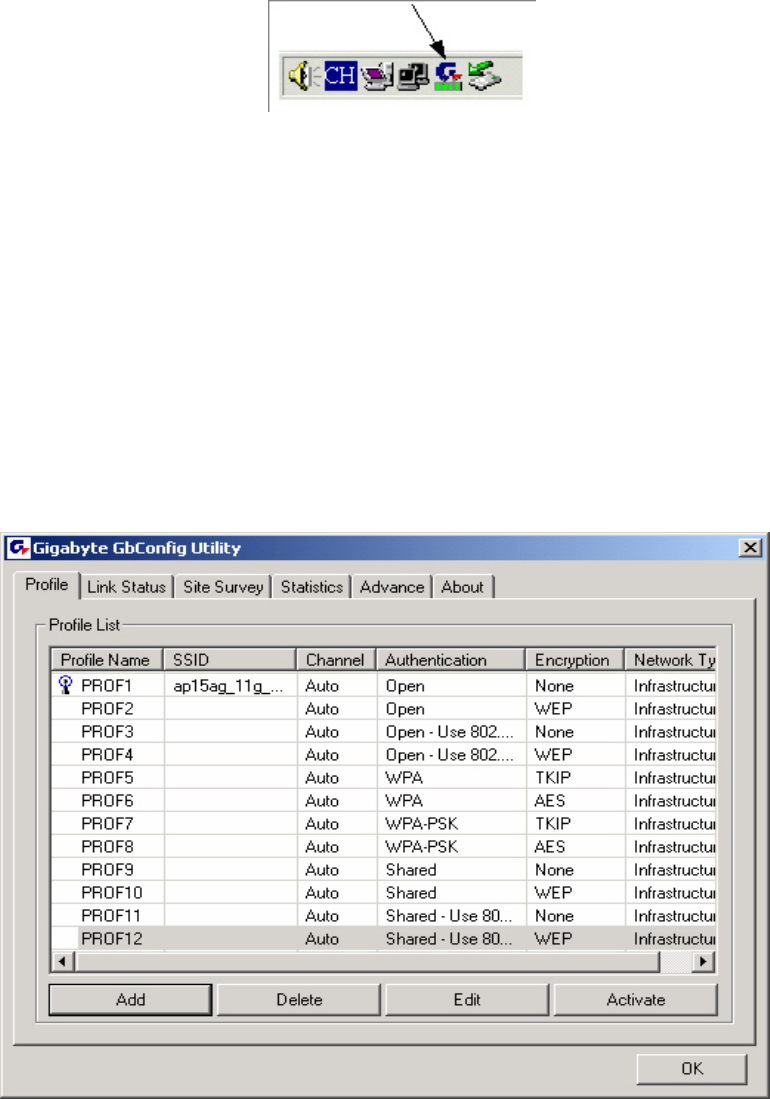
4
Chapter 3 Using the GIGABYTE WLAN Configuration
Utility
The Gigabyte WLAN Utility is a powerful application that helps you to configure the
GN-WI01GS-RH Wireless Mini-PCI Adapter as well as monitor the network status link. It
automatically appears as an icon in the system tray at the bottom right corner of screen
whenever the card is operating (see Figure 3-1). The icon displays signal strength (one
green box = weak signal, 4 green boxes = strong signal) and double-clicking on it
launches the utility.
Figure 3-1 Gigabyte Configuration & Monitor Utility Icon
You may also open the Gigabyte WLAN Utility from the Windows Start menu, selecting
Programs and then Gigabyte WLAN Utility.
Note: Modifications to WLAN configuration settings can be done when GN-WI01GS-RH is
in use or through the network configuration tool provided by Windows® when it is inactive.
3-1. The Profile Tab
Click on the Profile tab in the Gigabyte WLAN Configuration Utility to view the values for
each defined profile. Click the Add button to create a new profile (see section below for
further details), the Delete button to delete a selected profile, the Edit button to modify a
selected profile and click the Activate button to have a selected profile become active.
Figure 3-2 Profile Tab
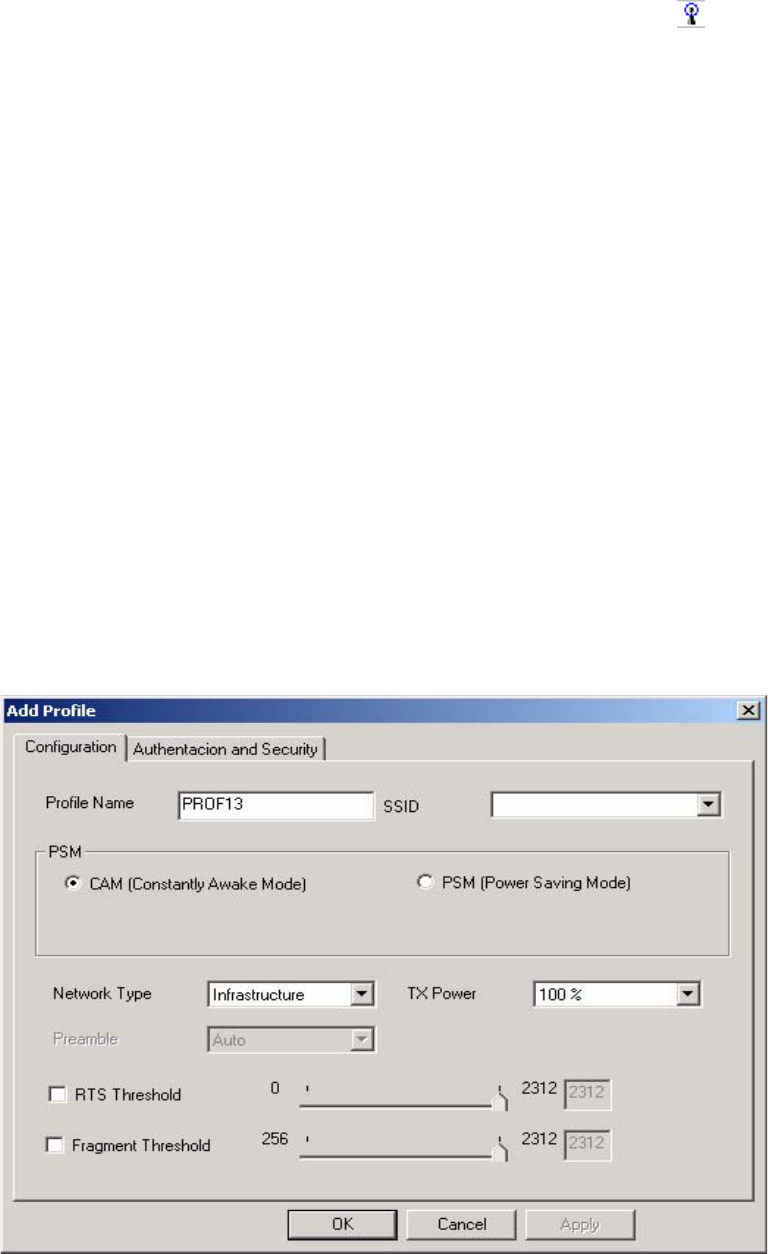
5
Profile Name -
Name associated with specific wireless parameters and settings. The icon indicates
the currently active profile.
SSID –
Displays the Service Set Identity (wireless network name) associated with active profile.
Channel –
Displays which channel the profile is operating on.
Authentication –
Displays authentication type associated with profile.
Encryption –
Four encryption types currently used in the profile include “None”, “WEP”, “AES” and
“TKIP”.
Network Type –
Displays the wireless mode (Infrastructure or Ad-Hoc) associated with the profile.
3-1-1. Add Profile – Configuration Tab
Figure 3-3 Add Profile – Configuration Tab
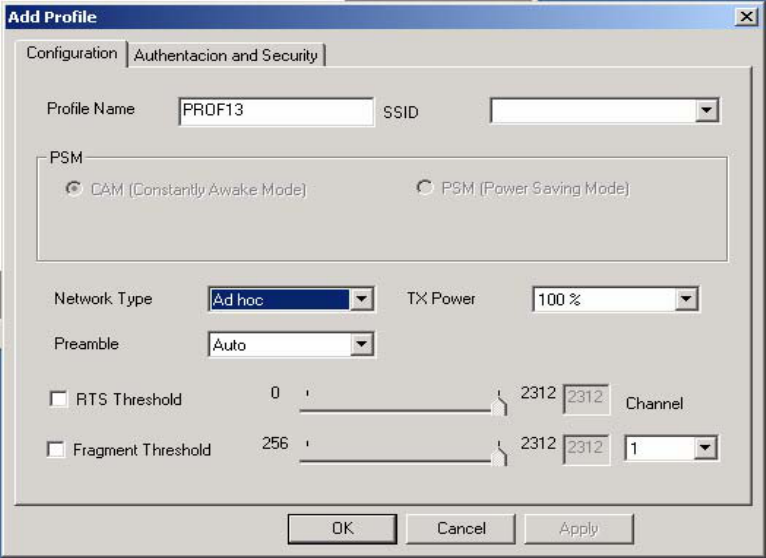
6
Profile Name –
Type in a unique profile name, set the corresponding parameters and click the Apply
button to add profile.
SSID –
Select a defined Service Set Identity detected by the system from the drop-down list or
input a new SSID (32-character maximum).
Power Saving Mode –
Select the PSM option to enable power saving feature (when no data will be transmitted)
or the CAM option to have device always on.
Network Type –
Displays the current wireless mode (Infrastructure or Ad-Hoc) the Mini-PCI Adapter is
operating in. Infrastructure is the most common and is used when connecting your PC to a
wireless access point or wireless router. Ad-Hoc mode is used to connect to another
computer without the use of a wireless access point or wireless router. In Ad-Hoc mode,
the Preamble and Channel can be manually set (see Figure 3-4).
Figure 3-4
TX Power –
Allows you to define the transmit power at various percentage levels with 100% being the
default value.
RTS Threshold –
Define the packet size the wireless node uses to determine appropriate transmission
mechanism.
Fragmentation Threshold –
Define the packet length used for fragmentation. Packets larger than value will be
fragmented.
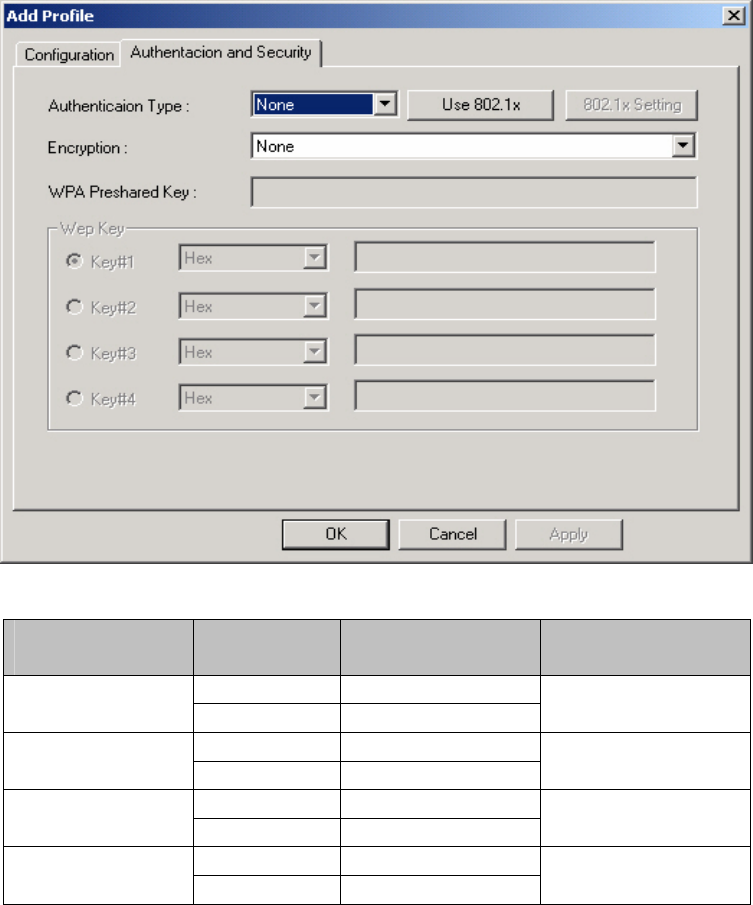
7
3-1-2. Add Profile - Authentication and Security
If an authentication or security setting is configured in a wireless access point or wireless
router, it is necessary for the Wireless Mini-PCI Adapter profile to match the security
parameters in order to obtain access and establish a connection. Both WEP Encryption
and 802.1X Authentication protocols are supported.
Figure 3-5. Authentication and Security
Table 3-1
Authentication
Type Security Secure Key
Setting 802.1X Enabled
None None None WEP Key Setting
YES
None None Shared WEP Key YES
TKIP None WPA AES None YES
TKIP WPA-PSK Key WPA-PSK AES WPA-PSK Key
NO
3-1-2-1. Authentication and Security
Authentication –
Before a station connects to a SSID, the authentication type used by the SSID must be
known. Authentication types include OPEN SYSTEM, WAP, WAP-PSK and SHARED.
Security –
To prevent unauthorized access to data transmitted on the network, WLAN card provide a
data encryption of high security. The access point must have the same password and
encryption to connect with you. Different authentication types have different level of
security. Please refer to Table 3-1.
WEP Encryption –
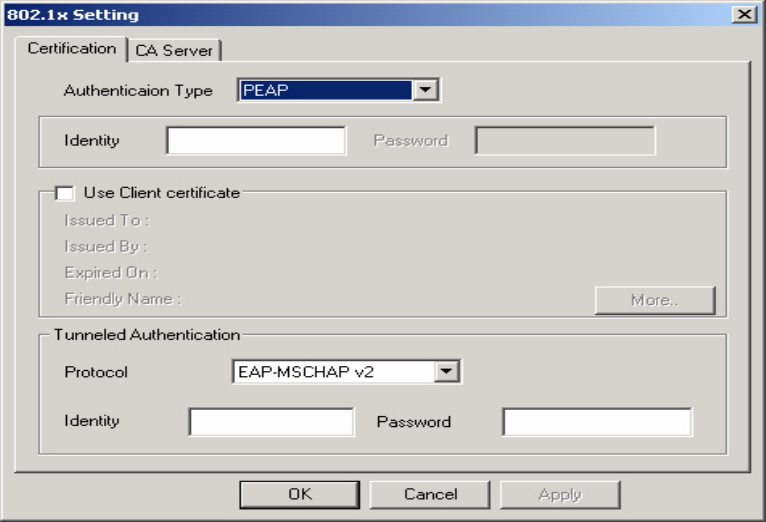
8
To activate the WEP Encryption, choose WEP Encryption from the drop-down menu in
the Encryption field. Then follow instructions below:
1. Select a Key. (You may specify up to 4 Keys)
2. Select data type as either Hex or ASCII. (Hex = hexadecimal)
3. Enter a WEP key. [For 64-bit: 10 hexadecimal digits, 5 ASCII; For128-bit: 26
hexadecimal digits, 13 ASCII]
4. Click OK to save the settings.
WPA-PSK Encryption –
To activate WPA-PSK (Preshared Key) Encryption using TKIP or AES, choose WPA-PSK
from the drop-down menu in the Encryption field. Then follow instructions below:
1. Enter a Preshared Key. [Key may be up to 64 hexadecimal digits or from 8 to 63 ASCII
digits in length]
2. Click OK to save these settings.
3-1-2-2. 802.1X Setting
To enable 802.1X Authentication, click on the Use 802.1x button (see Figure 3-5 above)
and the 802.1X Setting window will open. From the 802.1x Setting window you can
configure authentication parameters such as Tunnel Protocol, ID and Password and Client
Certificate or Certificate Chain.
Figure 3-6 802.1X Setting – Certification Tab
Authentication Type –
Choose authentication type from the drop-down menu. Authentication types supported
include PEAP, TLS/Smart Card, TTLS, LEAP and MD5-Challenge.
Identity –
Enter the name of the user account.
Password –
The option to specify a password is only available when LEAP and MD5-Challenge are
selected as the authentication types.
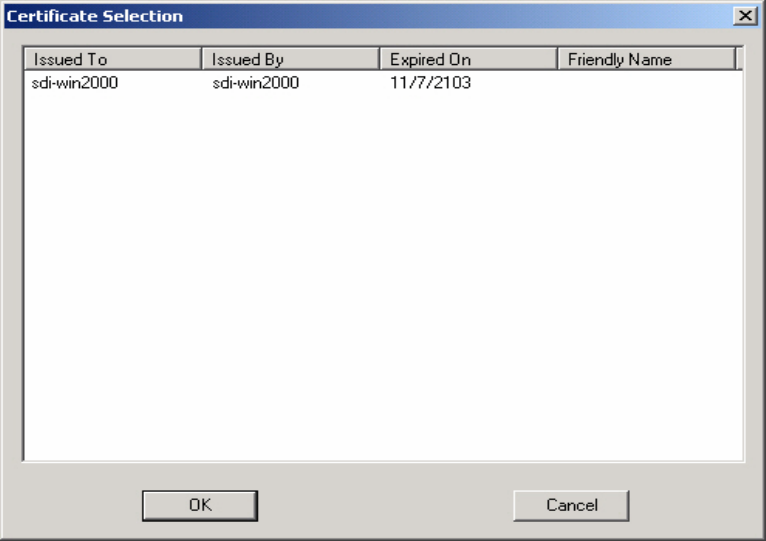
9
Use Client Certificate –
Check the Use Client Certificate box to confirm if the Client Certificate is correct in the
authentication process. This applies only to TLS and TTLS authentication types.
Tunnel Authentication –
PEPA and TTLS use two-step authentication method. The first step is that Server sets up
a Tunnel with its authentication. No option is need to be set for Station with WLAN card.
The second step is to confirm the validity of Station with assigned authentication type in
the Tunnel. Data needed for authentication includes Tunnel ID, Tunnel Password, Client
Certificate or Server Authentication.
Protocol: Use assigned authentication type in the safe tunnel.
Tunnel Identity –
Enter name of user account.
Password –
Enter the user account password.
Figure 3-7. Client Certificate List
Figure 3-8. CA Server Setting
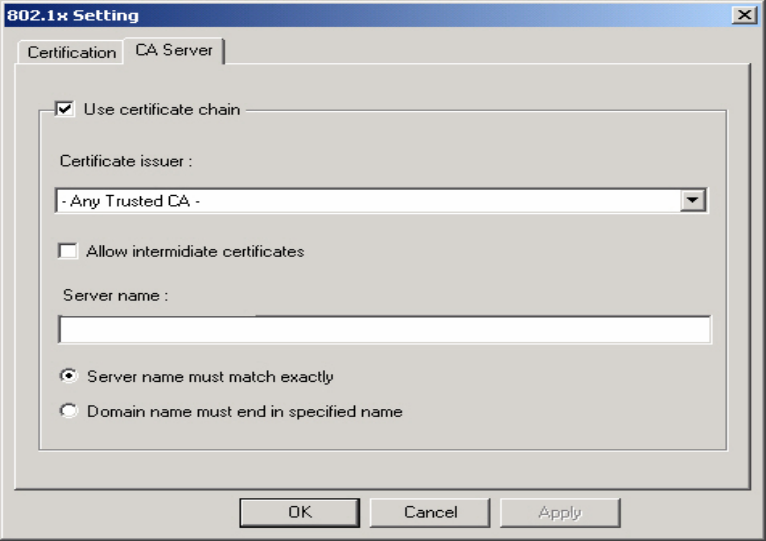
10
The CA Server is enabled only when TLS, TTLS or PEAP authentication is selected. The
Client can verify if such server is reliable and then transmit Client Certificate after the
verification is confirmed. (NOTE: Only available if Use Client Certificate is checked.)
Verify CA Server -
1. Confirm if the Server Certificate is issued by an assigned certificate issuer. If Allow
Intermediate Authentication box is checked, the server certificate can be issued by
one intermediate certificate issuer.
2. Check that the server name of server certificate matches the name entered by the user
or belongs to the same domain.
Server Certificate –
Check the Server Certificate box to indicate that the Client will confirm whether the CA
server is reliable.
Certificate issuer –
Specify the CA of a server certificate from the drop-down list.
Allow Intermediate Certificates –
When this option is checked, the certificate issuer can be an issuer recognized by a
specific certificate issuer.
Server name –
This value can be a server name or the name of a domain where the server is located.
Server name must match exactly –
Select this option to specify that the server name of server certificate must be the same as
Server Name or matches the name of domain where the server is located.
Domain name must end in specified name –
Select this option to specify that the certificate issuer must match the domain or secondary
domain entered in Server Name.
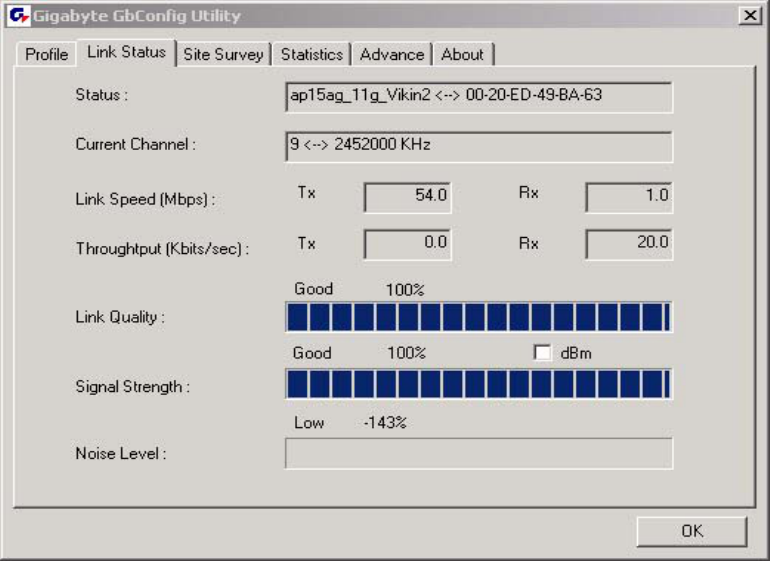
11
3-2. The Link Status Tab
The Link Status tab displays information on the current wireless network connection.
Figure 3-9. Link Status
Status –
Displays the SSID and MAC address of the associated access point when
GN-WI01GS-RH is configured in infrastructure mode.
Current Channel –
Displays the wireless channel currently in use ONLY when GN-WI01GS-RH is configured
in Ad-Hoc mode.
Link Speed –
Indicates the transmission data rate between associated access point and the
GN-WI01GS-RH
Throughput –
Indicates the number of successfully transmitted (Tx) and received (Rx) data (in bytes per
second.
Link Quality –
Displays how well the GN-WI01GS-RH is communicating with wireless access point,
wireless router or another wireless device.
Signal Strength –
Displays the signal strength received by RF signal processor in dBm.
Noise Level –
Displays the noise level of connection.
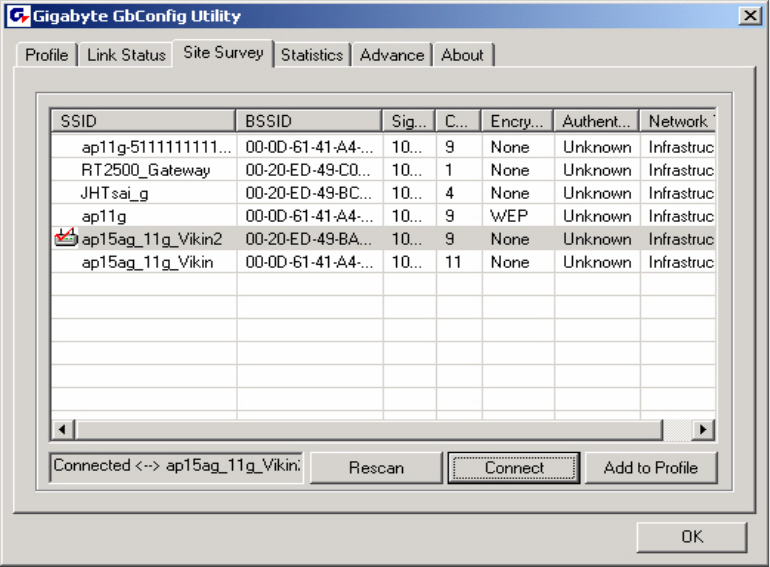
12
3-3. The Site Survey Tab
The Site Survey” tab shows you the list of available access points and/or peer-to-peer
stations. You can double click SSID that you want to connect or highlight the access point
and click the Connect button.
Figure 3-10. Site Survey
BSSID –
Displays the MAC address of the access point.
Signal Strength –
Displays the access point signal strength.
Channel –
Displays the current broadcast channel used by the access point.
Encryption –
The security method used by the access point.
Authentication –
The authentication type used by the access point.
Network Type –
Informs you if an access point (infrastructure) or other wireless node (802.11 Ad Hoc) is
connected.
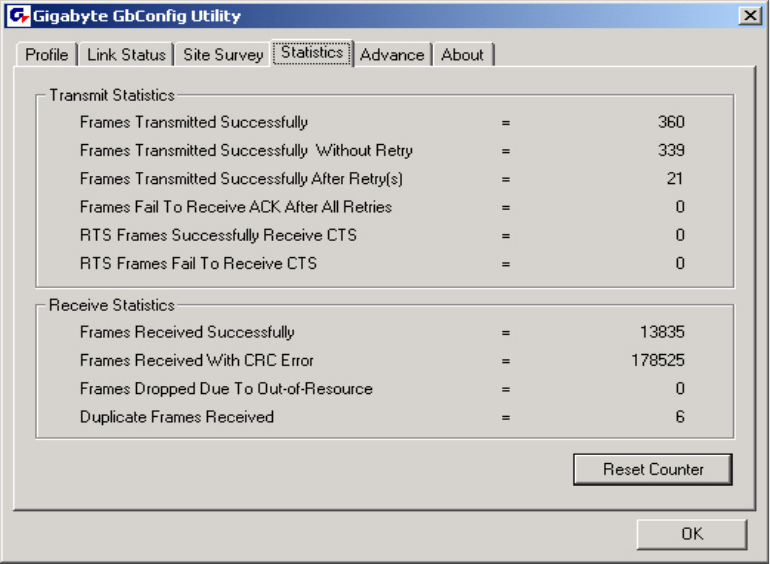
13
3-4. “Statistics” Setting
The Statistics tab shows you the number of packets sent and received by the Wireless
PCI Adapter.
Figure 3-11. Statistics
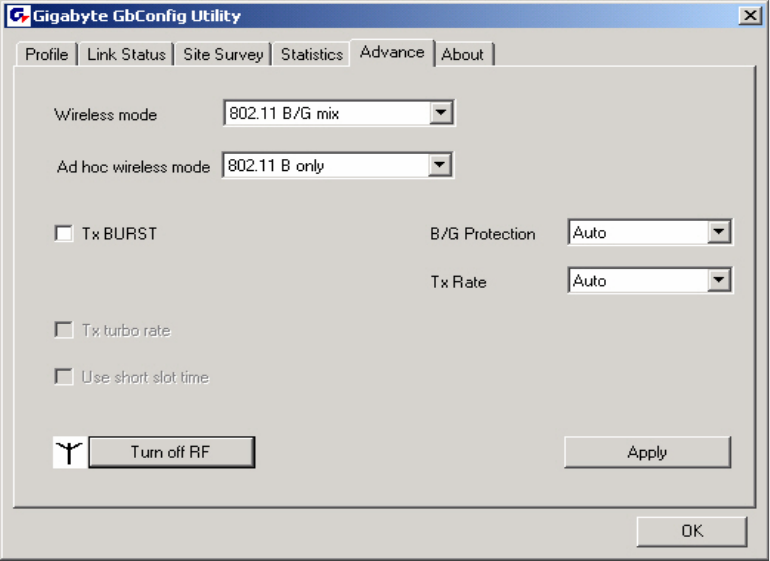
14
3-5. The Advanced Tab
The Advanced tab includes fields of various parameters to review or change drivers. Just
click “Apply” button to apply any parameter change to the driver in the tab. A reboot is not
needed for the WLAN card (see Figure 3-12)
Figure 3-12. Advance
Wireless Mode: Sets infrastructure Protocols, including 802.11 B/G mix and 802.11 B
Only.
Ad Hoc Wireless Mode: Sets Ad Hoc Wireless Protocols, including 802.11 B/G mix,
802.11 B Only and 802.11 G Only.
TX Burst: The longest interval between frames is normally one DIFS while frames are
transmitted. When this setting is open, the longest interval between frames is one SIFS
that means the system is allowed to transmit higher capacity of data in one interval.
B/G Protection: 802.11b uses CCK modulation. 802.11g uses OFDM while CCK
modulation for 802.11b is compatible. To prevent data collision between two stations with
802.11b and 802.11g within range of the same Access Point, it is necessary to set 11B/G
Protection. This setting only functions when 802.11 B/G mix is selected as Wireless Mode.
Three setting are available: AUTO, EABLE and DISABLE.
This is a mechanism implemented to prevent the “Hidden Node” problem, “Hidden Note” is
a situation in which two stations are within range of the same Access Point, but are not
within range of each other. Therefore, they are hidden nodes for each other and can not
detect each other. This mechanism is a way to prevent data collision when WLAN
equipments require transmission.
TX Rate: This option adjusts settings of TX Rate according to the setting of “Infrastructure
Wireless Mode”.
Signal Control: To turn off transferring signals, click on “Turn Off RF” icon on the bottom
right corner of the screen. Click “Turn On RF” to transfer signal again.
TX Turbo rate and Use short slot time: currently does not support.
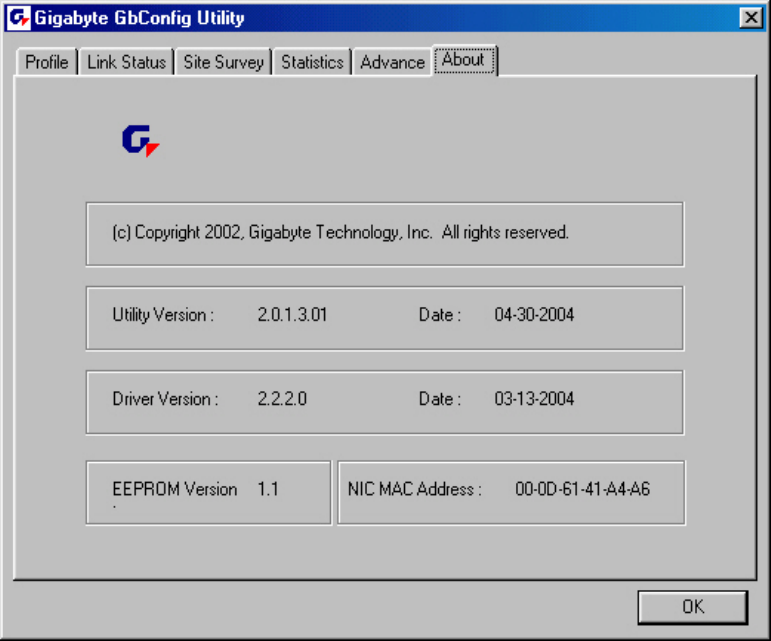
15
3-6. The About Tab
The About tab displays information about current drivers and physical MAC address.
Figure 3-13. About
16
Chapter 4 Troubleshooting
This troubleshooting guide lists questions and possible solutions to some common
problems which you may encounter while installing or using GIGABYTE Wireless Mini-PCI
Adapter.
Cannot Enable 802.1x, WPA or WPA-PSK
z Windows XP / 2000:
1. Run the AegisI5.exe file found on the GN-WI01GS-RH installation CD.
2. Click “Install”.
z Windows 98SE / ME:
1. Run AegisI2.exe file found on the GN-WI01GS-RH installation CD.
2. Click “Install”.
Cannot Establish Connection to a Wireless Network
z Make sure the SSID for the Wireless Mini-PCI Adapter is the same as the
wireless access point or wireless router.
z Make sure the security settings are the same as that of wireless access point /
router. If WEP or WPA encryption is enabled, check if the WEP or WPA keys for
the GN-WI01GS-RH match.
z Check that the MAC address of the Wireless Mini-PC Adapter is included in the
access point/router’s Authorization Table.
Can Connect to an Access Point, but Cannot Access the Internet
z Make sure the security settings are the same as that of wireless access point /
router. If WEP or WPA encryption is enabled, check if the WEP or WPA keys for
the GN-WI01GS-RH match.
z Verify the network settings (IP address, subnet mask, gateway, and DNS) of your
computer.
z Check that the proxy server of the WEB browser is correctly set.
Poor Link Quality and Weak Signal Strength
z Keep the Wireless Mini-PCI Adapter away from microwave ovens and large metal
objects to avoid radio interference.
z Locate the Wireless Mini-PC Adapter as near to the access point as possible.